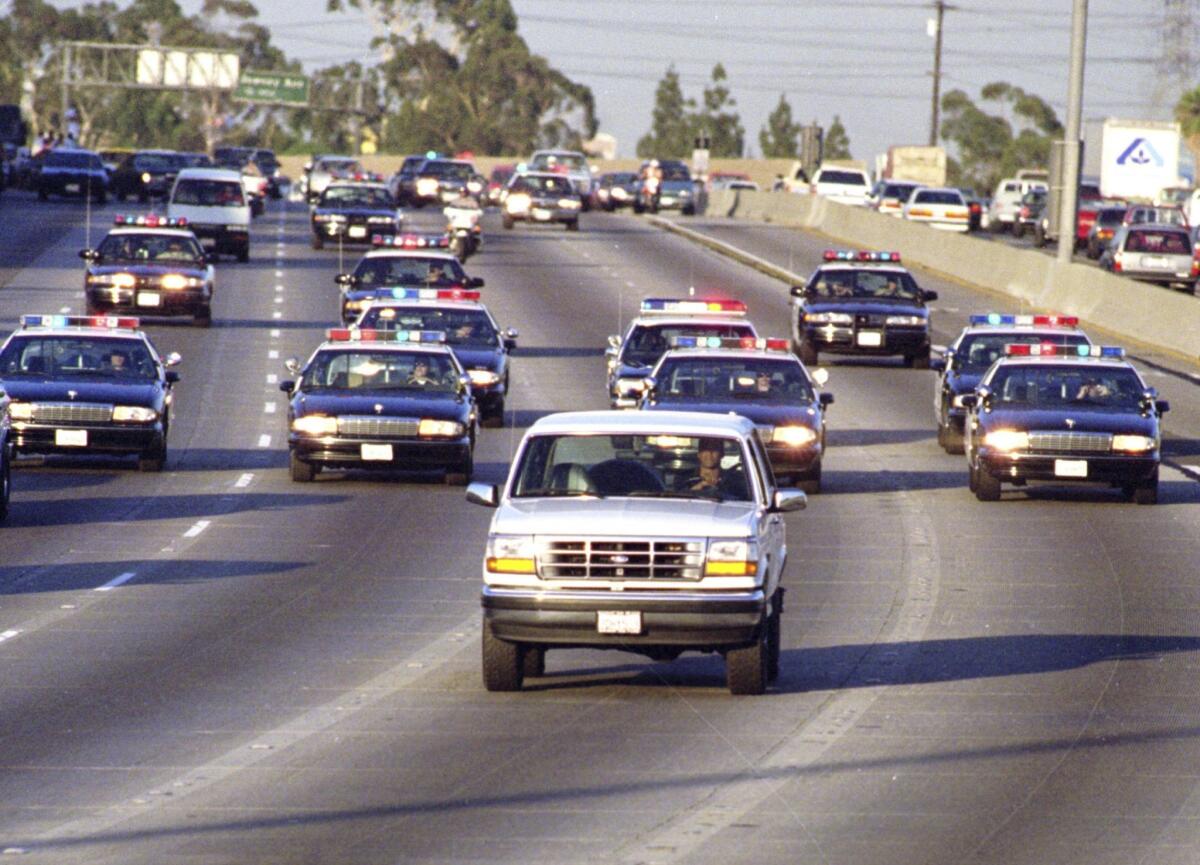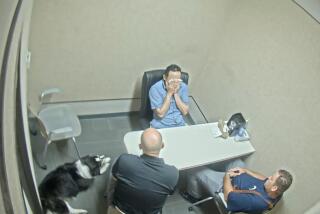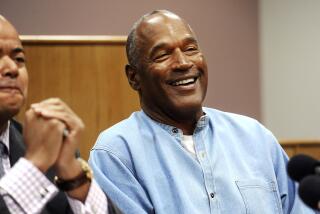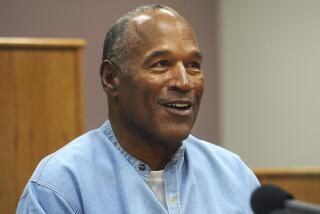From the Archives: Simpson Held After Wild Chase: He’s Charged With Murder of Ex-Wife, Friend

O.J. Simpson, the football great who rose from the mean streets of San Francisco to international celebrity, was arrested Friday for the murders of his ex-wife and a male friend after leading police on a gripping, two-hour chase through the rush-hour freeways of Southern California.
The dramatic capture of one of the best-known and best-loved public figures in America came shortly before 9 p.m., about 10 hours after he was to have turned himself in to Los Angeles police. Simpson’s lawyer, Robert L. Shapiro, said Simpson, 46, had agreed to surrender earlier, but bolted at the last minute with Al Cowlings, a longtime friend and former teammate at USC and with the Buffalo Bills.
A massive manhunt involving scores of law enforcement officers ended in the cobblestone driveway of Simpson’s Tudor-style mansion, as Los Angeles Police Department officers in bulletproof vests converged on the white Ford Bronco in which Simpson and Cowlings had fled.
As the truck sat parked, its hazard lights blinking silently in the balmy June night, Cowlings got out of the driver’s seat and walked into the house. Then, for nearly an hour, a distraught Simpson sat inside the truck, reportedly cradling a blue-steel revolver and demanding to speak to his mother.
Hundreds of supporters gathered in the upscale neighborhood, chanting “Free O.J.,” and rocking police cars. Meanwhile, the LAPD Special Weapons and Tactics team and negotiators surrounded the house, eventually coaxing Simpson out of the vehicle by cellular telephone. He put the gun down and emerged about 8:50 p.m. carrying a framed family photo.
Simpson went into the house, used the bathroom, called his mother and drank a glass of juice, authorities said. He was then transported by police motorcade to Parker Center for booking and transported to Men’s Central Jail. Cowlings was booked on suspicion of harboring a fugitive. He was being held on $250,000 bail.
The dramatic arrest, broadcast live on national television, capped a tragic weeklong drama that began with the slayings of Simpson’s ex-wife, 35-year-old Nicole Brown Simpson, and Ronald Lyle Goldman, a 25-year-old Brentwood waiter whom she knew.
Nicole Simpson and Goldman were found stabbed to death early Monday morning outside her Brentwood condo. Police sources said the two were slain sometime after 10 p.m. Sunday as her two small children slept inside.
Although the Police Department had refused all week to label Simpson a suspect, and Simpson’s lawyers said he was innocent, sources inside the LAPD made it clear from the outset that he was the focus of their investigation. The former college and professional football star was briefly handcuffed at his mansion Monday afternoon and taken to police headquarters for questioning. He was later released, and remained free as evidence mounted against him day by day.
By Friday, detectives had concluded their case, recommending that Simpson be charged with two counts of first-degree murder. The charges, which include a “special circumstance” of multiple killings, could bring him the death penalty if he is convicted.
Los Angeles Police Cmdr. David J. Gascon said Simpson had been scheduled to turn himself in to police at 11 a.m. Friday, with arraignment scheduled for that afternoon in Los Angeles Municipal Court.
But 45 minutes, and then an hour, ticked by and Simpson was nowhere to be seen. Finally, just before 2 p.m., police held a news conference to announce that Simpson had officially become a fugitive.
“He is a wanted murder suspect,” Gascon said tersely, “and we will go find him.”
It was unclear how the 6-foot-2, 210-pound Simpson--who had been dogged by crowds of reporters and cameramen for most of the week--had managed to escape authorities, who had felt confident that someone so famous would never attempt to flee.
Throughout the week, Simpson had appeared to be sequestered in his Brentwood home, emerging only to visit his children and to attend Nicole Simpson’s funeral in Orange County. After the services Thursday, a man resembling Simpson was photographed ducking past hordes of news reporters into the home--escorted by an off-duty LAPD sergeant.
Police sources said Friday, however, that the man who resembled Simpson was a decoy, who was under the escort of LAPD Sgt. Dennis L. Sebenik, a 25-year veteran who works in the LAPD Harbor Division. Police said they want to interview Sebenik.
Unbeknown to department leaders, Sebenik was serving as a member of Simpson’s security detail even as police were investigating the former football star.
Sebenik said he manages a “legitimate security company” and had been hired to provide security for Simpson. He would not comment on why an off-duty Los Angeles police officer was protecting a man widely reported to be a suspect in a double homicide.
Gascon said department officials were investigating Sebenik’s conduct.
“I’m not going to rush in here and defend anything that might have occurred, but I’m not going to rush to judgment either,” Gascon said. “We have no interest in excusing what is obviously going to be a difficult situation to explain.”
Shapiro said Simpson had been told Friday morning that he would have to surrender that day. Because of Simpson’s “fragile” emotional state, Shapiro said he had asked several doctors to join him at the San Fernando Valley home of Simpson friend Robert Kardashian, where a heavily sedated Simpson had spent Thursday night.
Shapiro said Simpson had spent the morning in the throes of what appeared to be a suicidal depression. He updated his will, the lawyer said, called his mother and his children and gave three sealed letters to a friend at the house.
One, addressed “To whom it may concern,” reiterated Simpson’s denial that he had any part in the murders, and reflected his anguish at the events of the past week.
“I think of my life, and feel I have done most of the right things,” the letter said. “So why do I end up like this? I can’t go on. No matter what the outcome, people will look and point. I can’t take that. I can’t subject my children to that.”
Shapiro said the plan for Simpson’s surrender had not been an unusual one, adding that he had made similar arrangements for other clients in previous cases. But the surrender, he said, had been delayed for nearly an hour by a medical examination of Simpson.
Police, impatient about the delays, called the house to say that they were coming to make the arrest. But Shapiro said he did not pass on that news to Simpson, who was with Cowlings in another part of the house.
It was apparently at that point that Simpson and Cowlings slipped away, Shapiro said.
From that point on, the afternoon was a frenzy of police activity and public astonishment.
In downtown bars people watched television sets, once primed for the championship basketball series, now tuned only to the breaking news story. At the Spectrum Club in Santa Monica, exercisers pedaled stationary bikes to TV sets tuned to coverage of O.J. Simpson’s temporary disappearance. Downtown streets were deserted. Even West Hollywood’s Sunset Strip, generally bumper-to-bumper with night-clubbers and party-goers, was empty.
At Tower Records on Sunset Boulevard, 15 television monitors were tuned to the Simpson story, and customers were transfixed.
“It’s paralyzed our business,” said manager Gary Wilde. “They’re just standing there in awe.”
What they saw was nothing less than the running to ground of one of the most famous murder suspects in U.S. history. Every move was chronicled on live television, a jump-cut documentary of an icon’s demise: now he was reported missing, now feared dead, now alive and headed south on Interstate 5.
Before the police could finish announcing that he had disappeared, the drama had shifted back to the scene of the crime.
Shortly after 2 p.m.--at almost the same moment that authorities were announcing to an audibly shocked press corps that Simpson was a fugitive--Nicole Simpson’s grieving father rushed from his daughter’s tile-roofed condominium, begging a teen-ager to dial 911.
LAPD Sgt. Bob Brounstein said a man claiming to be Simpson had called the house at least twice, saying he was coming over to the scene of the murders to kill himself.
“I’m going to go join Nicole,” the caller allegedly said. But Simpson never turned up at the residence.
“We have a big mess,” Sgt. Doug Abney told an anxious crowd. “This is a false alarm.”
Then, just before 6 p.m., Highway Patrol officers spotted Cowlings’ white Ford Bronco heading south through Orange County on Interstate 5.
A phalanx of police vehicles took off in pursuit, blocking traffic on the freeway and entrance ramps as Simpson and Cowlings wound their way through Orange County and back to Simpson’s Brentwood home.
During the pursuit, LAPD Detective Fred Lange, the lead investigator on the case, contacted Cowlings on the phone, and was told that Simpson was in the back seat with a gun to his head, that he would never surrender and that he wanted to see his mother.
As TV news choppers broadcast the astonishing spectacle--the white Bronco slowly wending its way across Southern California, a cadre of 20 black-and-white squad cars in its wake--traffic came to a halt along the freeways from Disneyland to Los Angeles and commuters jammed the overpasses to cheer and wave at Simpson as he passed. Some held up huge signs exhorting, “Go O.J.” Meanwhile, scores of callers from across the country pleaded with him over the airwaves on KNX-AM news radio to pull over and turn himself in.
The disappearance of Simpson threatened to create a public relations nightmare for the LAPD and the district attorney’s office, whose decision not to arrest the ex-football star earlier had been second-guessed in some quarters. Police sources had been saying all week that the evidence against Simpson was strong enough to warrant his arrest, and yet the department held off, hoping to build an airtight case before taking him into custody.
Gascon said the department was “very unhappy” with Simpson’s disappearance and stressed that police had not given Simpson special treatment in their handling of the investigation.
Dist. Atty. Gil Garcetti, who described himself as “upset and angry” about Simpson’s disappearance, also defended the Police Department’s performance, saying investigators had done a commendable job at building the case against the former athlete.
In the four days after the killings, police sources say, evidence steadily mounted linking Simpson to the crimes.
Bloodstains on the walkway where the bodies were found matched Simpson’s blood type, they said, and two bloodstained gloves were recovered, one at the scene, its match outside his Brentwood home.
Polices sources also said that a trail of blood drops stretched across Simpson’s cobblestone driveway. And Friday, they said that bloodstains inside his home matched Nicole Simpson’s blood type. The blood evidence appeared to figure against Simpson but is not necessarily conclusive, sources said. Even the rarest blood types are shared by many people.
Garcetti said that a murder weapon, which he described as a “substantial knife,” had yet to be found.
It was shortly after midnight Sunday that the blood-soaked bodies of Nicole Simpson and Goldman were found sprawled on a Spanish-tile walkway outside her Brentwood condominium. Coroner’s investigators said both their throats had been slit, and their corpses bore multiple stab wounds.
Within hours, police began looking for Simpson, who, they later learned, had taken an 11:45 p.m. flight to Chicago.
Notified of his ex-wife’s death, Simpson returned to Los Angeles, arriving shortly before noon.
As police bore in on Simpson during their investigation, he changed lawyers, hiring Shapiro on Tuesday. But Shapiro said his client grew increasingly distraught and began undergoing treatment for depression.
At his news conference Friday, Shapiro said he and Simpson’s doctors feared that the football great might attempt suicide. One of Simpson’s last acts before disappearing had been to write the three letters to his children, his mother, who was hospitalized in San Francisco Friday night, and to the public.
Although the letters to his children and mother were not released, close friend Kardashian, who joined Shapiro at the news conference, read the public letter to a hushed group of reporters on live television.
In it, Simpson expressed regret for the life that he would never have with his current girlfriend and thanked a list of former teammates, golfing buddies and good friends. He acknowledged the much-publicized fights with his ex-wife and their recent decision not to reconcile after years of turmoil, but characterized them as the natural ups and downs of long relationship.
He urged the news media to leave his children in peace. And he denied that he was the man who committed the brutal killings.
“I have nothing to do with Nicole’s murder,” Simpson wrote. “I love her, always have and always will.
“Don’t feel sorry for me,” the letter concluded. “I have had a great life, great friends. Please think of the real O.J., and not this lost person.”
The Sequence of Events
FRIDAY
MORNING
8:30 a.m.: Robert Shaprio, lawyer for O.J. Simpson, receives call from LAPD officials telling him to surrender his client.
9:30 a.m.: Shapiro goes to an undisclosed home in the San Fernando Valley, and informs Simpson he will have to surrender by 11 a.m.
Murder charges are filed against Simpson in the slayings of Nicole Simpson and Ronald Goldman; arraignment is scheduled for the afternoon.
11 a.m.: Simpson is scheduled to surrender.
AFTERNOON
Shortly afternoon, accoridng to Shapiro, the lawyer receives call from LAPD officials telling him that police must annonuce that Simposon is a fugitive. he gives police directions to the house.
Police arrive at the San Fernando Valley house. Shapiro, who is with Simpson’s doctors and others in a room at the house, says Simpson and Al Cowlings, a former college and pro football teammate of Simpson who had been with him, had left the house.
1:50 p.m.: LAPD Cmdr. David Gascon announces that Simpson has not surrendered for arraignment as scheduled and is a fugitive.
2 pm.: Police respond to 911 call at the scene of the slayings, after a man identified as Nicole Simpson’s father comes out of the house asking people to call 911.
3 p.m.: LAPD officer at Nicole Simpson’s condominium tells reporters, “O.J. Simpson is not here.”
Dist. Atty. Gil Garcetti, at news conference, says anyone helping Simpson to flee will be prosecuted as a felon. “We will find Mr. Simpson and bring him to justice.” Police are searching for his former teammate, Cowlings. Garcetti says prosecutors have not decided whether to seek the death penalty in the case.
4:45 p.m.: Police issue an arrest warrant for Cowlings.
EVENING
5 p.m.: Shapiro holds press conference, during which a longtime Simpson friend, Robert Kardashian, reads a letter from Simpson: “Don’t feel sorry for me,” ends the note. “I’ve had a great life, great friends. Please think of the real O.J. and not this lost person. Thanks for making my life special. I hope I helped yours. Peace and love. O.J.”
5:51 p.m.: Simpson reportedly makes a 911 call from the cellular phone in his Ford Bronco. His location is traced to the Santa Ana Freeway in Orange County near Lake Forest, where his ex-wife, Nicole, was buried Thursday.
5:56 p.m.: CHP begins pursuit.
7:30 p.m.: After moving onto the Artesia Freeway, the Bronco turns north on the San Diego Freeway in Torrance, soon encountering crowds standing on the roadway and overpasses.
7:57 p.m.: Simpson and Cowlings arrive at Simpson’s Brentwood home and negotiations for surrender begin.
8:47 p.m.: Police issue an all-clear after taking Simpson into custody.
9:37 p.m.: Simpson arrives at Parker Center in police custody.
More to Read
Sign up for Essential California
The most important California stories and recommendations in your inbox every morning.
You may occasionally receive promotional content from the Los Angeles Times.











